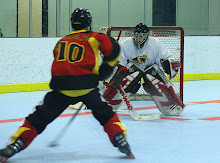Monday, November 3, 2008
Division II Rankings - 11/03/08
#1 – Neumann College - 2025.68
#2 - West Chester University - 1947.07
#3 - University of California, San Diego - 1882.27
#4 - Cal Poly Pomona - 1738.74
#5 - Missouri State University - 1716.21
#6 - Truman State University - 1706.15
#7 - Elon University - 1671.16
#8 - SUNY Albany - 1635.64
#9 - University of Maine - 1623.87
#10 - Grand Valley State - 1622.85
#11 - St. Louis University - 1590.17
#12 - University of Northern Colorado - 1586.52
#13 - Kennesaw State University - 1582.77
#14 - Florida Atlantic University - 1572.05
#15 - Drexel University - 1564.84
#16 - Shippensburg University - 1562.31
#17 - Rowan University - 1555.14
#18 - University of South Florida - 1553.46
#19 - University of Tampa - 1550.20
#20 - University of California, Davis - 1546.34
#2 - West Chester University - 1947.07
#3 - University of California, San Diego - 1882.27
#4 - Cal Poly Pomona - 1738.74
#5 - Missouri State University - 1716.21
#6 - Truman State University - 1706.15
#7 - Elon University - 1671.16
#8 - SUNY Albany - 1635.64
#9 - University of Maine - 1623.87
#10 - Grand Valley State - 1622.85
#11 - St. Louis University - 1590.17
#12 - University of Northern Colorado - 1586.52
#13 - Kennesaw State University - 1582.77
#14 - Florida Atlantic University - 1572.05
#15 - Drexel University - 1564.84
#16 - Shippensburg University - 1562.31
#17 - Rowan University - 1555.14
#18 - University of South Florida - 1553.46
#19 - University of Tampa - 1550.20
#20 - University of California, Davis - 1546.34
Subscribe to:
Post Comments (Atom)
The Rankings Explained
Since the conclusion of the season both founders set out to find the best solution to answer the age old question, “Who’s #1?” After much search, the answer was to use a mathematical formula to calculate the answer. Removing the human element from the voting would likely result in less biased rankings towards individual teams and regions.
The solution would be found in the ELO chess rating system. They system was created to rank chess players by another means that wins, losses and draws. The system uses a mathematical formula to reward each person for impressive feats and punish them for lesser impressive feats. Because chess and inline hockey are two different animals, the general equation had to be changed to allow for more hockeys related factors into the equation.
Using the FIFA Women’s World Rankings as a guideline (Elo Based), we managed to change the rankings to suit the nature of our sport. The rankings include the importance of the game, the outcome of the game, the expected result of the game, and the goal differential of the game when calculating a result. To better explain the way the rankings work I give you the following examples (all team start with a ranking of 1500):
Lindenwood University (1500) vs. UMSL (1500): If Lindenwood won the regular season game 4-3; they would be awarded 15 points for the victory and UMSL would be docked 15 points. However, if the game was won 12-2, Lindenwood would earn 39.38 points for the victory and UMSL would be docked 39.38 points. Additionally, the importance of the game could change, using the national title game as the example, with both teams having equal ratings Lindenwood would be awarded 52.5 points for a 6-3 win.
However, as you could assume, two teams having the same rating would be rare. Each teams point total carries over from one week to the next and from one season to the next. The following is a example of two teams with different point values and the different results it can produce.
Lindenwood University (1746.38) vs. Illinois State (1360.88): There are a few things that you can determine because of the vast difference in each teams rating (385.5). The first is that Lindenwood is expected to win the game. The second is that Illinois State winning the game would be a much bigger accomplishment that Lindenwood winning the game. The maximum points Lindenwood can earn from this game is 7.72, which would mean they won by at least 10 goals. However, on the flip side, if Illinois State was to win the game by at least 10 goals they could earn as many as 71.03 points. This is based on the projection that Lindenwood would win the match-up 90% of the time.
As the two examples show, there are a bunch of positives when using this system. For starters, once a team has achieved a high rating, it becomes difficult for them to increase it without playing a higher level of competition. This rewards regions that have more competitive teams. It also rewards teams who travel out of the region and win games against other higher rated teams. For example, last season, Towson and Army both played James Madison who would have had a higher rating that both visiting teams. In the games, Army and Towson both won handily and would have increased their ratings while negatively hurting James Madison. But, the hidden bonus is they now can bring those rating points back into their region. Those points then become spread out over the entire region as the season progresses and teams win and lose.
For the ratings system to work, each game has to have a certain amount of value attached to it. In the system we will be using five different levels to rate the importance of any give game. The first level is the lowest level of importance; it contains all pre-season exhibition games. The second level includes all regular-season regional games, as well as cross-divisional exhibition games. Level three includes all cross-regional games and invitational based tournaments, like WinterFest. The fourth level includes all regional playoff games and the fifth and final level includes all national playoff games.
The solution would be found in the ELO chess rating system. They system was created to rank chess players by another means that wins, losses and draws. The system uses a mathematical formula to reward each person for impressive feats and punish them for lesser impressive feats. Because chess and inline hockey are two different animals, the general equation had to be changed to allow for more hockeys related factors into the equation.
Using the FIFA Women’s World Rankings as a guideline (Elo Based), we managed to change the rankings to suit the nature of our sport. The rankings include the importance of the game, the outcome of the game, the expected result of the game, and the goal differential of the game when calculating a result. To better explain the way the rankings work I give you the following examples (all team start with a ranking of 1500):
Lindenwood University (1500) vs. UMSL (1500): If Lindenwood won the regular season game 4-3; they would be awarded 15 points for the victory and UMSL would be docked 15 points. However, if the game was won 12-2, Lindenwood would earn 39.38 points for the victory and UMSL would be docked 39.38 points. Additionally, the importance of the game could change, using the national title game as the example, with both teams having equal ratings Lindenwood would be awarded 52.5 points for a 6-3 win.
However, as you could assume, two teams having the same rating would be rare. Each teams point total carries over from one week to the next and from one season to the next. The following is a example of two teams with different point values and the different results it can produce.
Lindenwood University (1746.38) vs. Illinois State (1360.88): There are a few things that you can determine because of the vast difference in each teams rating (385.5). The first is that Lindenwood is expected to win the game. The second is that Illinois State winning the game would be a much bigger accomplishment that Lindenwood winning the game. The maximum points Lindenwood can earn from this game is 7.72, which would mean they won by at least 10 goals. However, on the flip side, if Illinois State was to win the game by at least 10 goals they could earn as many as 71.03 points. This is based on the projection that Lindenwood would win the match-up 90% of the time.
As the two examples show, there are a bunch of positives when using this system. For starters, once a team has achieved a high rating, it becomes difficult for them to increase it without playing a higher level of competition. This rewards regions that have more competitive teams. It also rewards teams who travel out of the region and win games against other higher rated teams. For example, last season, Towson and Army both played James Madison who would have had a higher rating that both visiting teams. In the games, Army and Towson both won handily and would have increased their ratings while negatively hurting James Madison. But, the hidden bonus is they now can bring those rating points back into their region. Those points then become spread out over the entire region as the season progresses and teams win and lose.
For the ratings system to work, each game has to have a certain amount of value attached to it. In the system we will be using five different levels to rate the importance of any give game. The first level is the lowest level of importance; it contains all pre-season exhibition games. The second level includes all regular-season regional games, as well as cross-divisional exhibition games. Level three includes all cross-regional games and invitational based tournaments, like WinterFest. The fourth level includes all regional playoff games and the fifth and final level includes all national playoff games.










5 comments:
Cincinnati goes 3-0, beating a D1 team and gets nothing?
Grand Valley is overrated.
Ball State is also going to be fairly strong in the D2 division.
Central Michigan may make some noise as well.
cincinatti beat two terrible teams.... purdue is not a good DI team. ball state will not be good, central might be ok. grand valley is not overrated. I saw them play last year at nationals and their core is returning. guess you will have to wait and see. it looks like they play some games this weekend
haha ... Let it go.. Don't cry about not being ranked when you are in your first year and beat a terrible DI team and a mediochre DII team twice. And don't judge teams that you haven't even seen play yet. How do you know ball state will be good when they have been terrible in the past. How can you say grand valley is overrated when they haven't played yet? And how can you say that central will be good in their first year In DII? Stop crying.........
Actually, I'm not from Cincinnati...I just think they're going to have a good team because they've got multiple players from a former semi-pro roller hockey club on their team this season.
That's my outside opinion on Cincy.
Grand Valley was overrated last season. D2 in the MCRHL was very weak. They played well at the beginning of the year but flat out struggled in the second half.
Central looked good in "B" last year...they are fast
Ball State has four kids from a prominent high school ice program. Two more kids come from an Indiana state finals runner up team.
Please read the information on how the rankings are calculated.
Post a Comment